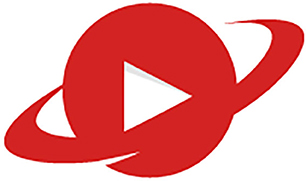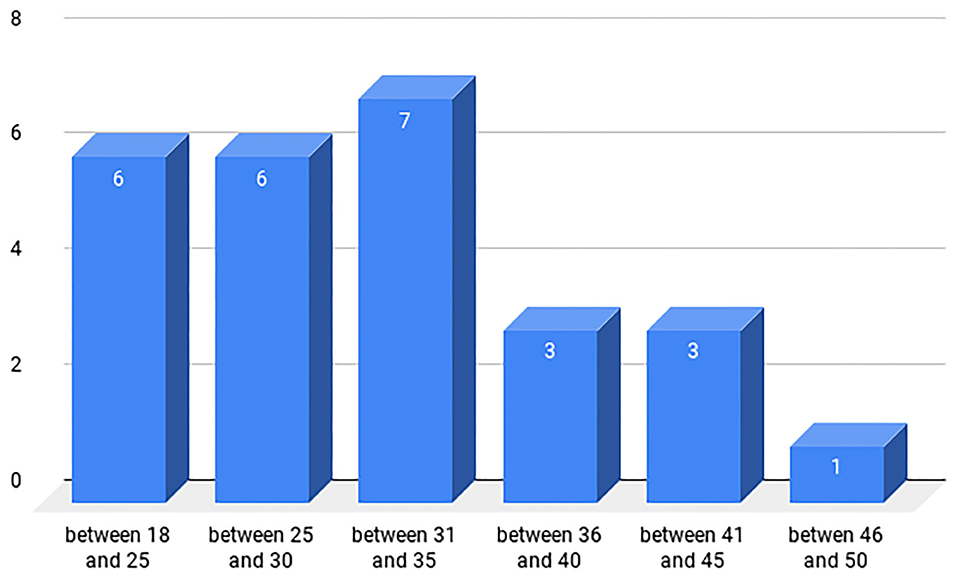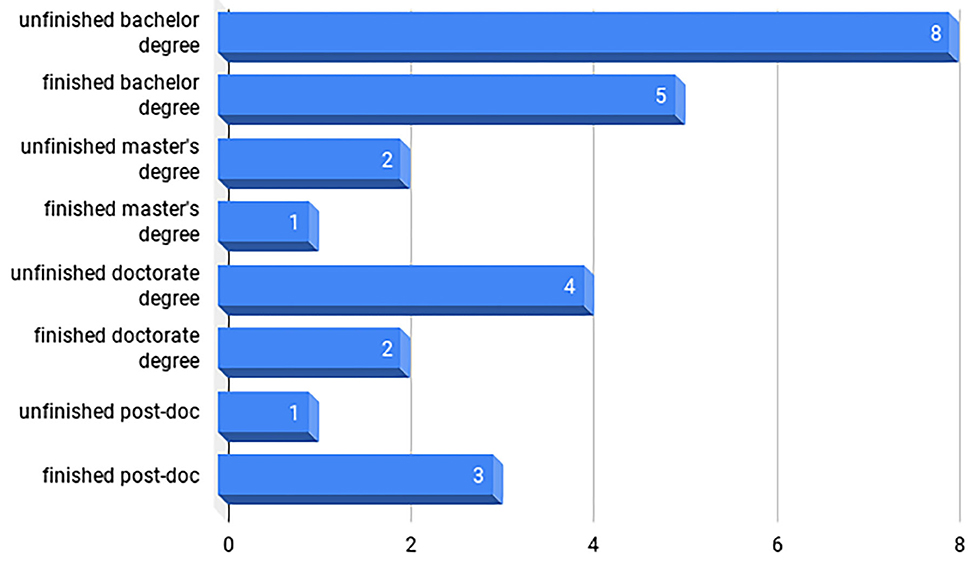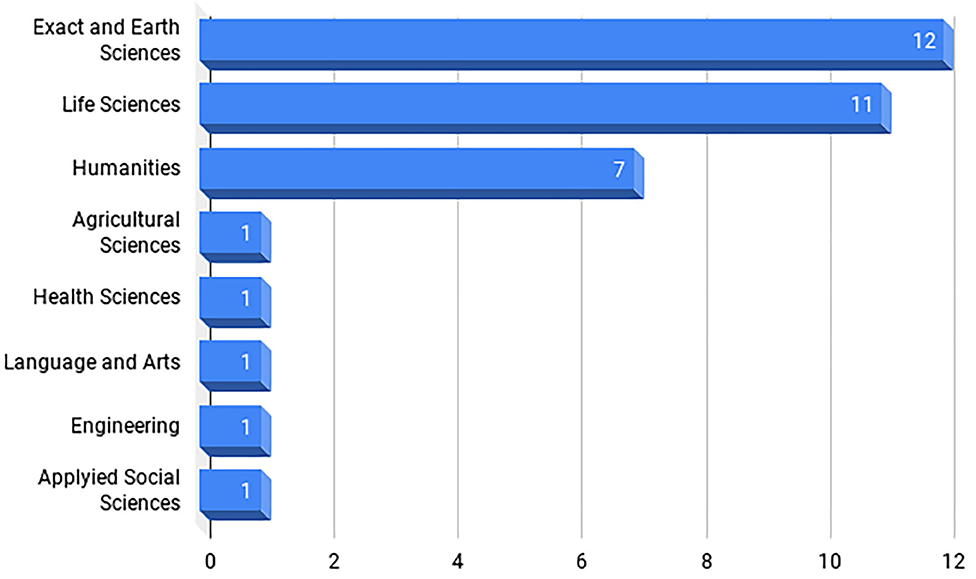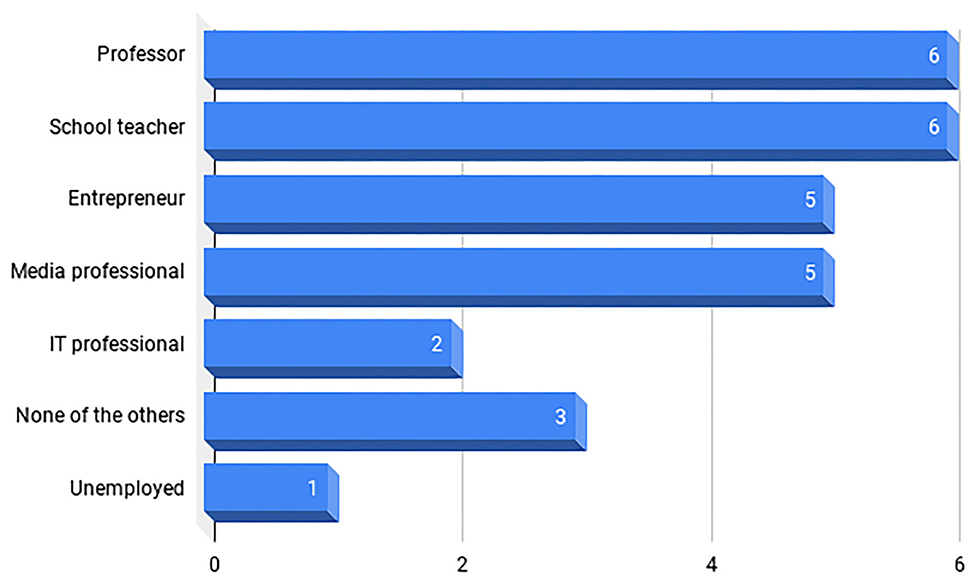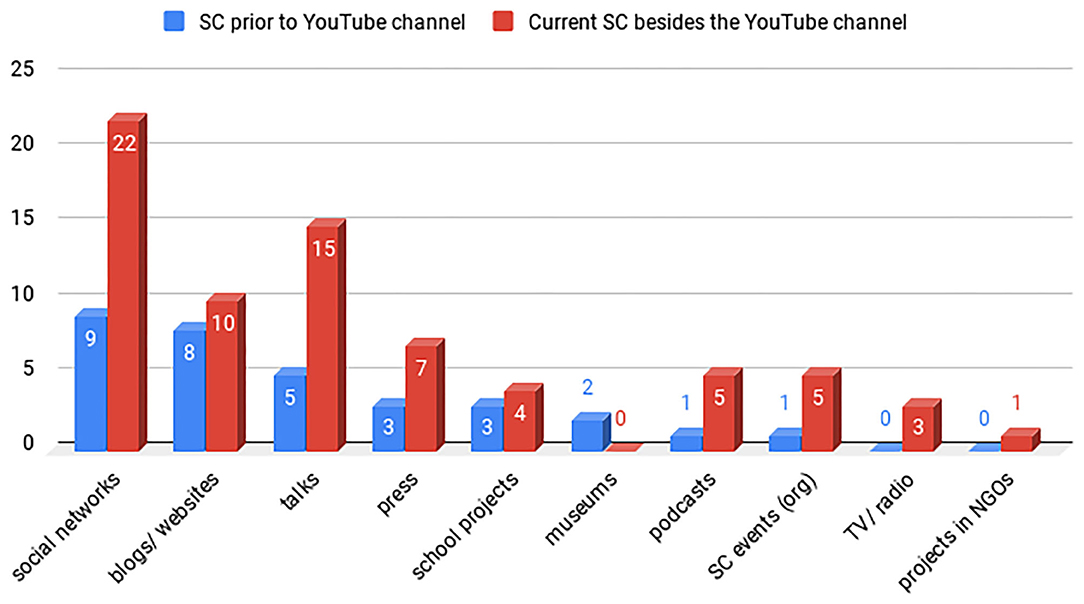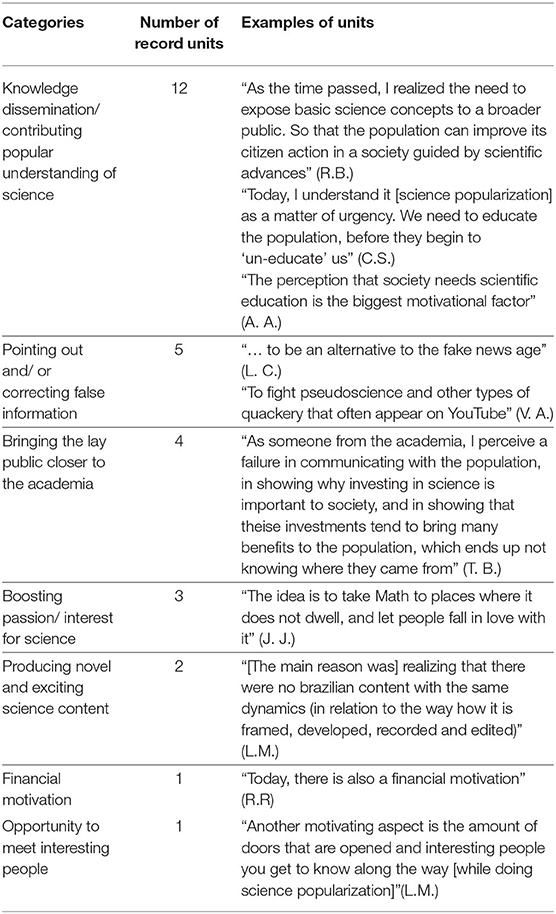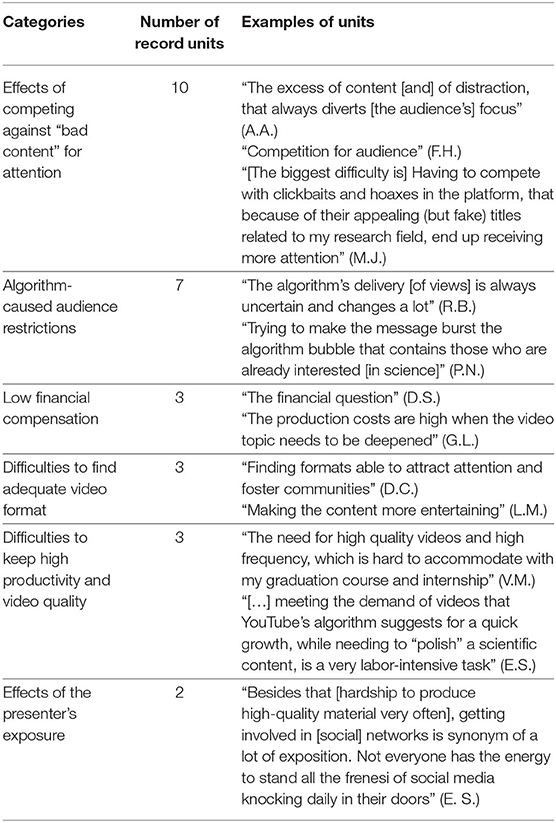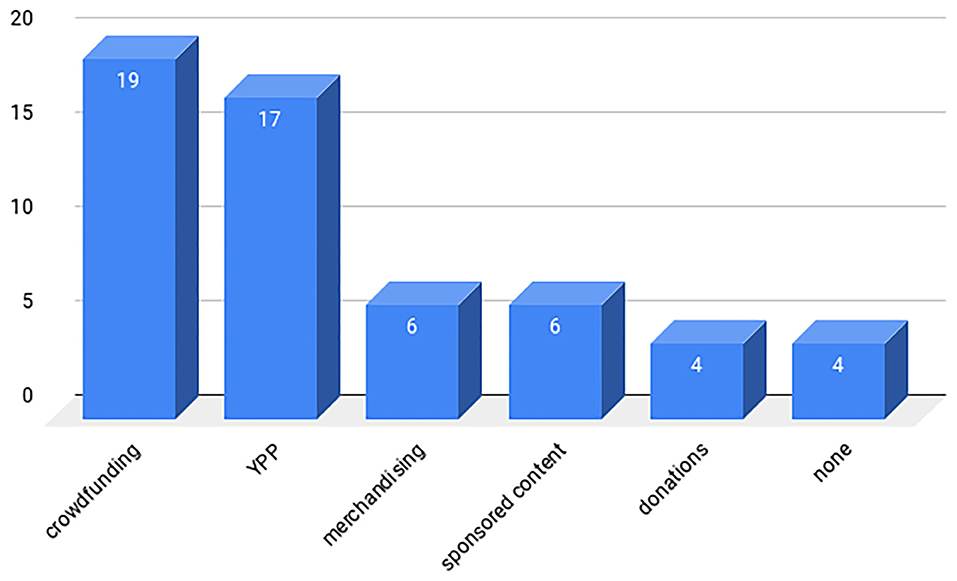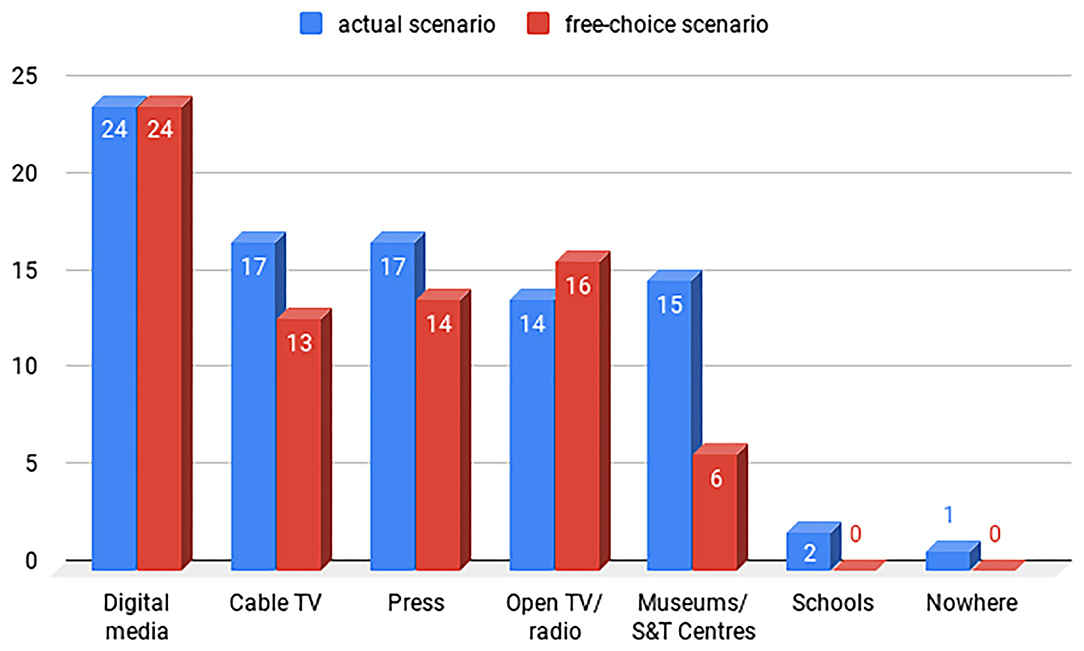- Laboratory of Advanced Studies in Journalism, State University of Campinas, Campinas, Brazil
This paper investigates the profiles, challenges, and motivations of science communicators of the ScienceVlogs Brasil project—a Brazilian alliance of YouTube channels that disseminate science information on YouTube. It also looks into their prospects of professionalization in science communication and their strategies to improve their skills, increase public reach, and have financial support. Results show that the typical science YouTuber is a highly educated young male who works primarily in the education field, wishes to improve science understanding and fight misinformation, and is challenged by YouTube's highly competitive environment and restrictive algorithms. Science YouTubers also strive to improve their skills and techniques to produce high-quality, professional-like videos to become visible on the platform.
Introduction
Throughout time, various media formats have been used to inform (and sometimes misinform) the public about science on the internet (Davies and Hara, 2017). Both online adaptations of conventional formats, such as broadcasting and print media, and internet-specific media, as information portals, news feeds, video and audio clips, and blogs, among others, have been pointed out as important tools for communicating science in the internet (Minol et al., 2007). More recently, social media websites such as Facebook (Zielinska, 2017), Reddit (Jones et al., 2019), and Twitter (López-Goñi and Sánchez-Angulo, 2017) have also been recognized as science communication loci, not least because of the increasing number of internet users that are informed about science through social media in countries such as the USA1 and Brazil (CGEE, 2019). Correspondingly, sociological studies exploring the range of online-active science communicators have included more and more actors. If in earlier times the online communicative activities of scientists, postgraduates and science journalists were the main focus (Bonetta, 2007), today the literature started to contemplate new actors and organizations, such as online citizen science hubs and amateur communicators active in blogs and on social media (Acatech, 2017; Riedlinger et al., 2019).
One of the new platforms to gain prominence among the new media is YouTube. Founded in 2005 as a video repository website with social media features (Vonderau, 2016), it later became one of the most-accessed video-sharing platforms worldwide, with currently two billion monthly logged-in users and nearly 500 hours of uploaded video every minute2. Public science communication has been taking place for years on YouTube in the form of science TV shows and documentaries, content posted by university and research center channels, and videos by independent science YouTubers, among others. However, research on it is still in its early stages (Allgaier, 2020). The existing literature has addressed a broad range of issues, such as the development of a typology of popular web science videos (Morcillo et al., 2016; García-Avilés and de Lara, 2018), types of (mis)information found resulting from queries of scientific terms (Allgaier, 2019), the framing of controversial scientific issues (Erviti et al., 2018), and the role of entertainment in science videos (Bourk et al., 2018). In short, some aspects of the production, consumption, of the videos and of the platform itself have been tackled; however, to the best of our knowledge, there has been so far no sociological qualitative study focused on independent science communicators on YouTube.
In this study, we fill this gap in the literature by doing an exploratory qualitative study around a community of Brazilian science communicators on YouTube, or science YouTubers. We use the term “YouTuber” as the synonym of a communicator who constantly produces and uploads videos to YouTube. YouTube is a massive platform in Brazil, which lands in fourth place in the ranking of YouTube views by country and as the third country with the most subscribers3. We conducted a survey with 26 members of the ScienceVlogs Brasil project—an alliance of Brazilian independent science YouTubers and a badge of scientific content—to gain insights into their personal profiles, motivations, and challenges in communicating science on the platform. Through the survey, we also explored their previous experiences in communicating science and their professional goals in the area. Additionally, we interviewed the coordinator and former director of the ScienceVlogs Brasil project to better understand how the project arose, how it currently functions, and what constitutes the scientific quality badge maintained by it. As the ScienceVlogs Brasil project is closely connected to the ScienceBlogs Brasil network in many aspects, we at various points draw comparisons between science bloggers and webvideo producers. We consider this a good analytical tool to better understand the emergence of science communicators on YouTube.
We start this article by offering a brief literature review on the sociology of online science communication, focusing on the ongoing transition of readership from science blogs to social networks. We then proceed to analyse some of the changes that YouTube as a platform has undergone over the years, which resulted in a more competitive environment and an impulse to the professionalization of content production, among other outcomes. Details on the research methodology, timing, and instruments used are offered in “Research Design and Methods.” In the “Findings” section, we start by describing the history and functioning of the ScienceVlogs Brasil project in the homonymous section. We then proceed for the other results in sections “a. Profile of science YouTubers,” “b. Motivations to communicate science,” “c. Challenges in communicating science on YouTube,” “d. Financial support,” and “e. Professionalization of Science YouTubers.” The “Discussion” section follows with some important considerations and confrontations of the findings with relevant literature. The “Conclusion” section completes the paper. A translated copy of the survey sent to the YouTubers and the script of the main topics discussed in the interviews can be accessed as Supplementary Materials.
A Shift on the Online Science Communication Landscape
A great part of the literature on the sociology of public science communication seems to be concentrated around science blogs. An example of this focus is the recent attempt to build a sociological framework to research science blogging by Jarreau (2015), who declared them a “critical point of departure for a modern study of science media production” (Jarreau, 2015, p.15). Science blogs, aside from being used for scholarly communication among peers (Bonetta, 2007), have also been used as a way to reach out to lay audiences (Bonetta, 2007; Shanahan, 2011; Masters, 2013; Mahrt and Puschmann, 2014). Independent science bloggers following this purpose include scientists, science journalists, graduate students, and hobbyists (Bik and Goldstein, 2013; Mahrt and Puschmann, 2014). Science authors who communicate to the larger public often do so “to increase awareness about science and/ or to facilitate discussion and decision-making on issues of importance to society” (Kyvik, 2005, p. 289), and thus, to promote a democratization of science (Wilkins, 2008). However, some authors argue that the aim of popularizing science tends to be short-lived due to the context-specific information and specialized language commonly used in science blogs, which tends to leave lay people out of the conversation (Kouper, 2010).
As a medium for public science communication, science blogs have different advantages and pitfalls. Bik and Goldstein's (2013) list of pros and cons of online tools for communicating science include blogs' post longevity and the reliability of the platform for building an online reputation as pros, while the cons include a considerable time investment and the need to advertise the posts in other platforms. Blogs are also seen as attractive due to the editorial freedom that they enable to the author, and also the possibility of conversations through comments (Blanchard, 2011). Lack of revenue derived from blogging and the undervaluation of the activity by many colleagues in academia, who often see this as waste of time, are seen as challenges (Brown and Woolston, 2018).
Presently, there is a good amount of evidence indicating the decline of the consumption and production of science blogs. Fausto et al. (2012) noticed a decrease both in science blog views of the Research Blogging website (a multi-language science blog indexer) and in the number of blog posts, starting in 2010. It has also been shown, in a study with 106 Brazilian science blogs, that the number of active blogs has fallen to 50% from 2013 to 20164. In 2013, authors of the Brazilian branch of the ScienceBlogs network observed a decrease in the general number of views of the blogs (Rodrigues, 2015). This phenomenon has also been observed worldwide, in international aggregators such as the Science Seeker5. In contrast, the number of users on social media websites has increased enormously in the last years—their current penetration is 46% (3.534 billion), with nearly all of them being mobile users6. Worldwide, people have spent on average 2 h and 23 min per day on any social media in 20197. In Brazil, this number goes up to a little more than 3 h of social network usage per day8, which makes Brazilians one of the most socially connected populations of the planet.
This trend comes accompanied by a rising amount of video content uploaded to the internet. Mobile video views have grown from ~5 min per day in 2012 to more than 30 min in 2018 for the average global user9. YouTube, in this context, has grown to become the second-largest website in the number of access worldwide10. Brazil is currently YouTube's sixth biggest market: as of 2017, 63% of the Brazilian population has visited the platform, and 44% watched at least one video on YouTube a day11. According to a recent survey, Youtube is the third source of information for Brazilians (49%), after TV (50%) and Whatsapp (79%) (Câmara, 2019). When it comes to information about science and technology though, the internet has surpassed TV and all other media, and Youtube is the third most relevant media in Brazil, after Facebook and search engines (CGEE, 2019).
Taken together, these data may suggest that part of the authors and readership of science blogs have migrated to other media and platforms, being YouTube one of the possibilities. Regarding the authors, while there is some evidence that in the international arena (and especially in the USA) many science bloggers now have writing careers, are clustered in official blogging networks or have expanded to podcasting, youtubing and book-writing (Brookshire, 2016). In Brazil, the whereabouts of former science bloggers are still unclear. Considering that one of the founders of the Brazilian ScienceBlogs was part of the creation of the ScienceVlogs Brasil, this paper may partially answer this question.
The Platform YouTube and the “New” YouTubers
YouTube, as a platform, can be described as a socio-technical digital structure specialized in extracting, processing, and marketing the data of its users (Srnicek, 2017). Langley and Leyshon (2017) argue that platforms function as intermediaries between customers who make up distinct markets; their task, in this context, is to coordinate these markets and capture data produced by the customers' interactions. As an advertising platform—that is, a platform that markets data of users to advertisers (Srnicek, 2017)—YouTube negotiates the interests of users (those who consume and/ or post content), who are on the platform for reasons that go from sheer entertainment12 to the pursuit of fame (Stokel-Walker, 2019); the interests of advertisers, who wish their ads to reach certain target audiences; and the interest of the platform itself and its investors, which seek to maximize profits. The results of this intermediation of interests performed by the platform include an increasingly verticalized relationship among users, an overload of content on the platform, and a push for the professionalization of amateur content (van Dijck, 2013). We argue that this shift on the ethos of the platform and its creators has an important impact on the motivations and challenges of science communicators on YouTube.
Since its foundation, in 2005, YouTube has encouraged user-generated video content as a way to attract and secure a large audience, and to catch the attention of professional media companies (Vonderau, 2016). As a result, YouTube promoted a strong participatory culture since its early years, powered by its social networking features and community-inducing interface features (van Dijck, 2013). In 2006, Google bought YouTube, started to settle court cases regarding intellectual property and copyright laws, and paved the way for the platform to receive increasingly more content from the broadcast industry (van Dijck, 2013). This brought about some tension between the “grassroots” native community of amateur YouTubers, who wished to keep the platform as a creative powerhouse for amateurs, and the new channels of TV personalities. To appease the users, YouTube expanded an existing program and launched the YouTube Partner Program (YPP), which allows users to monetize their videos on the platform with Google's AdSense when their channels and videos follow the platform's guidelines and some other criteria.
In the following years, as the number of users mushroomed and the number of “passive viewers” supplanted the number of users with at least one video posting (Cheng et al., 2008), various social media features were eliminated from the website, and the successive layout revamps were increasingly built around a producer/consumer or star/fans logic (van Dijck, 2013). The progressive institutionalization of the platform (Kim, 2012) ultimately resulted in a new ethos for the typical content creator: the professional YouTuber, capable of producing easily findable and interesting quality content. With an ever-increasing amount of videos uploaded to the platform, content creators who wish to be watched constantly feel the need to know more about the functioning of the algorithms (Pedersen, 2019), about how to reach and hold an audience, and other ways to gain visibility (Holmbom, 2015). The push for high-quality standards has been given by YouTube itself through its YouTube Creator Academy website and the YouTube Creators channel and blog, which contain courses and tips for content creators to grow their channels with quality content. At the same time, creators must be careful with the choice of words and themes in the video, since some of YouTube's algorithms have up until recently demonetized videos that did not disregard the platform guidelines, but only touched on polemic topics13.
To this day, very little is known about how science YouTubers manage to navigate this intricate environment and reach their goals. How do independent science YouTubers perceive YouTube? What are their main challenges in making their channel reach more people, and how do they fund themselves? What strategies do they use to overcome such difficulties? Motivated by these and other questions, we designed and carried out this research.
Research Design and Methods
In order to obtain information about the emergence and current functioning of the ScienceVlogs Brasil project on YouTube, we conducted and recorded two interviews with the project founders. The first interview took place in November of 2017 with R.B., prior coordinator of the project. The second interview happened in January of 2019, with both R.B. and V.P., the project director. The interviews were semi-structured and approved by the Unicamp Ethics Committee (process number 1686032). The recordings in Portuguese are available to the public through the link https://drive.google.com/open?id=1h0ymVRckwx5d_WBnyrARh0NTWUBNNbTF. The sources of information (either one of the founders) will be indicated by the initials of each subject and the year of the interview to preserve their identities.
We also elaborated a survey aimed at the YouTubers using the GoogleForms service, tested it with four graduate students, and modified it for understanding enhancement. The questionnaire was sent in October of 2018 to R.B., the project coordinator, who moderated the invitation with project members. The survey contained various open and closed-ended questions and a completing answering time of about 12–15 min. It was divided in four sections: (a) sociodemographic data; (b) relationship of each YouTuber with science communication; (c) the YouTuber's relationship with YouTube as a website and a platform; (d) and, strategies for communicating science on YouTube.
By the end of November of 2018, the link for the online questionnaire was deactivated and the answers were analyzed. We recommended that only one channel host answered the questionnaire, regardless of how many hosts the channel could have. We obtained 26 answers from 25 channels, from a total of 36 active channels that composed the project at that time. That means we obtained two different answers from one channel. We decided to keep both of them because they came from two YouTubers who previously had two different channels, but then had recently decided to merge and present the same channel. We reckoned that they had mostly different experiences as science YouTubers, and therefore both views could add valuable information to the results. The English version of the survey is available in the Supplementary Materials.
The method used to analyze open-ended questions was content analysis, as defined by Bardin (1977). In the first step, the pre-analysis, all the answers were carefully read, in order to exclude any unfitting responses. During the second step, some thematic categories were identified, and the record units were defined as entire responses or fragments of responses that belonged to one of the categories. In the third step, record units were grouped together and counted according to the categories, some of which were merged together when adequate; and in the last step, interpretation of the categories and answers took place. This process was performed for three questions: two of them about the motivation of the YouTubers to communicate science, and one about the difficulties of doing science communication on YouTube. There were other open-ended questions asked, but their answers are mostly off-topic for this article and will be analyzed in future works.
Findings
The ScienceVlogs Brasil Project
The project was created by R.B. and V.P., both of them biologists and former science bloggers. They reported noticing a sharp decrease in the number of science blog readers since 2013, while, at the same time, many Brazilian YouTube science channels were gaining ever-growing audiences. This motivated them to start a channel network on YouTube, loosely based on the ScienceBlogs Brasil network, a model already familiar to them since R.B had been coordinator of the network in the past. In 2015, the founders started inviting science Youtubers, and in March 2016 the project was officially launched, with 18 channels14.
According to one a blog post written by a member of the project15, the goals of the ScienceVlogs Brasil project are concentrated on fighting scientific misinformation on YouTube through the creation of a “quality badge” that enables the lay public to identify scientifically accurate information. This badge (Figure 1) was designed as a graphic symbol that all channels belonging to the project and videos about science made by project members should exhibit, but in practice it is used almost only in the official channel of the project.
Still according to Ayrolla, other objectives of the project are leveraging the reach of each channel individually through strategies such as cross referencing (hosts talking about each other's channels in the videos) and invigorating the presence of science in the platform, through the popularization of the ScienceVlogs Brasil brand. Up to the date of publication of this article, the project did not have an official webpage or blog, but it owns an account both on Facebook and Twitter, and an official channel on YouTube.
As we gathered the data, in October and November of 2018, ScienceVlogs Brasil comprised 39 YouTube channels, with diverse themes and styles. Many channels are thematic and focused on the communication of Biology, Astronomy, Physics, Robotics, Mathematics, Geography, and Archeology. Most of them tend to approach more than one single theme, with some of them bridging great areas of science. For example, the host of channel “Alimente o Cérebro” (Feed your Brain) speaks about philosophical concepts and also presents the latest research about Astronomy. The target audiences vary significantly in terms of age. Some channels produce content clearly directed at children (“Quer que desenhe?”—Would you like me to draw it?), while others aim at the adult public (“Boteco Behaviorista”—Behaviorist Pub—and “Universo Racionalista”—Racionalist Universe). Most of them seem to target a young adult public, based on their editing style and approach to themes (the links to all channels are listed in the Supplemental Materials. It is important to mention that science YouTubers often use their channels to express thoughts about politics, music and culture, or to talk about their hobbies and personal life, with very few exceptions. That means that there is a spectrum from channels that touch exclusively on their scientific theme of interest (such as “Space Today,” a channel about Astronomy and space exploration) and channels that (more often than not) tackle non-scientific themes (e.g., channel “Xadrez Verbal”—Verbal Chess). The exact content makeup of each channel is determined by its presenter, without editing interference of the project direction. Admissions of new content creators to the group occur on occasion, in rounds that involve a five-step process including evaluations of videos of the new channel, the posture of the presenter and a general voting by all members.
Profile of Science YouTubers
We inquired about the Youtubers' gender, age, education (area and level), current occupation and area of residence, and we obtained 26 answers. Most of the science Youtubers are men (76.9%, 20 people). Figure 2 shows that 73.1% (19 people) are young, between 18 and 35 years old, while 26.9% (7 people) are above this range.
Figure 3 shows that 50% of the sample are either doing graduation or are already graduated, while 50% are currently doing or have completed a postgraduate course. Figure 4 shows that 46.5% (12 people) have studied Exact (or Physical) and Earth Sciences at some level of their academic career, followed by 42.0% (11 people) who studied Life Sciences and 26.9% (seven people) who studied a course in Humanities. Other fields were less representative, and had one indication each.
As seen in Figure 5, 23.1% (six people) work as school teachers; 23.1% work as university professors; 19.2% (five people) work in Communications (journalists, people employees of publishers, TV or radio), 19.3% are self-employed (entrepreneurs); 7.3% work in the IT sector and the four remaining did not specify. At least half of the YouTubers have more than one occupation. The most common scenario is working as a teacher and having another occupation, such as graduate or undergraduate student (four people), entrepreneur (two people), and media professional (one person).
Participants were then asked about their activities as science communicators before and after they created their YouTube channel. Prior to their channel on YouTube, most YouTubers were active either in social networks (nine people) and/ or in blogs and websites (eight people). “Talks and workshops” was the third most marked option (five people). There was a notoriously small number of people participating in podcasts and in the organization of SC events. Participants could mark as many options as they saw fit.
Their current activities as science Youtubers cover a broader range. In Figure 6, it is shown that most of them use social networks (22 people, 84.61%), and a significant amount (10 people, 38.46%) still blog. Social networks, this time, are a clear preference, also because they are frequently used for advertisement of the YouTube channels, as we discuss later on. Talks and workshops were again a popular option (15 people, 57.69%). New options appeared this time, such as participation in TV and radio (three people, 11.53%) and work in NGOs (one person, 3.84%); besides, more communicators now participate in podcasts. On the other hand, no Youtubers reportedly work in museums and science centers.
Respondents were asked how many years they had participated in science communication activities before starting their YouTube channel, and the nature of such activities. Of the 18 people who were active before the YouTube channels, half of them (nine people, 34.61% of the whole sample) had been doing SC for some time between 1 and 3 years, and seven people (26.92% of entire sample) had been active for 5 years or more. No one had been active for 1 year or less before starting SC activities, which indicates a presence of a considerable level of experience in science communication among them.
Motivations to Communicate Science
As shown in Table 1, the top motivation to communicate science, far above the rest, is the perceived need of the population to be “educated” about scientific issues. Some YouTubers expressed the “citizenship effect” that comes from popularizing science, as F.H. when he stated that “a society that is scientifically literate becomes more efficient in decision-making and critical reasoning, and also in the oversight of our political leaders.” E.S., for example, stated that the aim of his channel is “to make people understand the importance of science, and to make them start to think by themselves, and not being easily manipulated.” Others highlighted the personal joy in sharing knowledge, such as P.P.: “The pleasure of educating and sharing knowledge still is the biggest reason why I communicate science” and V.A.: “My motivation is to keep studying and sharing my knowledge with a bigger community.”
Challenges in Communicating Science on YouTube
The high competition for attention in a platform full of “clutter” (A.A.) makes it harder for the science YouTubers to “remain relevant and searchable among so many other types of entertainment” (J.J.). It is also hard for them to “bust the filter bubble” (P.N.) and reach new audiences. The lack of revenue for their work in producing videos, in its turn, impairs their ability to dedicate more time to the process of video production, which can be seen in Table 2.
Strategies for Communicating Science on YouTube
We asked in the survey, using closed-ended questions, how often they perform some actions to increase their reach in the platform and how often they consult some sources to learn more about how the platform operates. The answers are shown in Table 3.

Table 3. Strategies and sources of knowledge used by science communicators to comprehend and navigate YouTube.
We also found that 19 people (73.03%) have already participated on-site courses given at the YouTube Space16 in Brazil, and that at least 19 people (not exactly the same ones) participated in at least one competition promoted by YouTube, such as the YouTube NextUp. The strong engagement of the YouTubers with some types of learning initiatives (on-site courses and the consumption of content on how to produce better content and reach more audiences) indicates a high commitment with their activities on YouTube, and hints at the formalization of this commitment in the form of professionalization (an issue that we explore further on).
Financial Support
When asked about the types of financial support they had to produce videos on YouTube, and informed that they could mark as many options as needed, participants answered the following (Figure 7):
Crowdfunding, marked by 19 people (73.1%), and the revenue from video ads, marked by 17 (65.4%), surpassed the other option by a large margin. Still, a relevant number of participants resort to sponsored content (six people, 23%), advertising often for science-themed products such as t-shirts; and to their own merchandising (six people). Some participants (four people, 15.38%) are also supported by direct personal donations. The ScienceVlogs Brasil project itself does not receive funding of any kind; only the individual members through their own initiative.
Professionalization of Science YouTubers
In the survey, we asked “would you consider becoming a professional in the area of science communication?” We specified that being a “professional” meant spending most of one's active time doing SC, and also drawing most of one's revenue from it. Eighty percent (21 people, 80.76%) confirmed that they would consider a career in the area of science communication. Two of those who responded positively already consider themselves professionals (one of them is the project coordinator, and the other lives mostly with the ad revenue from his channel). The three YouTubers who responded “no” (11.5% of the sample) are university professors, who would rather stick to their careers in academia. Then we asked where they would like to operate as SC professionals if they could choose freely, and also where they think they would have a real chance to be professional in the actual scenario. The answers are shown in Figure 8. The majority chose digital media both at in the actual and free-choice scenarios, followed by the press, cable TV and open TV on the actual scenario, showing they are happy with where they are working, except for science museum or science centers that wouldn't be a free-choice place to work, although 15 respondents were working there at the time of the survey.
Discussion
ScienceVlogs Brasil can be best understood as a result of further development of the online media ecosystem, in which audiovisual language grew in popularity thanks largely to cheaper gadgets with cameras and an online connection and a recent increase in broadband coverage in Brazil17. YouTube is reportedly the most accessed social media in Brazil18; 96% of people between 18 and 35 years access it19. In this sense, it is fair to say that the project was created as a way to try and reach the audiences that may have migrated to YouTube from other media, and also to engage with all the new young audiences who are native to YouTube. As a project stemming from science communicators directly connected to the ScienceBlogs Brasil project, it borrows a lot from the decentralized and non-edited model of a blogging network, which is reinforced by YouTube's individualistic top-down structure (van Dijck, 2013). However, the project aims at popularizing the ScienceVlogs Brasil badge through collaborations between channel members. As such, the project acts as a platform in the sense detailed by Gillespie (2010)—it attempts to promote a “progressive and egalitarian arrangement, promising to support those who stand on it” (Gillespie, 2010, p.4). Through mutual help, the members of the project produce interesting content, help their channels to grow by sharing audiences, and offer each other emotional support, attempting to operate as a true platform where YouTube fails.
Science YouTubers appear to be younger than science bloggers: in Jarreau's (2015) comprehensive study of science bloggers (n = 601), 46% of the authors are in the window of 18–34 years old, while 27% of the sample are between 35 and 44 years old. In this study, 73.1% of the science YouTubers are aged between 18 and 35, while the rest are above this age bracket. The age difference seems to be closely related to the moment in the career of the YouTubers, and, consequently, with his or her educational attainments: while there is a great variety of bloggers in different moments of a variety of careers and occupations—science writers, postgraduate students, researchers, and professors (Bonetta, 2007; Puschmann, 2014), little more than a third (nine people, 34.61%) of the science video producers in our sample is still in college, and so are younger and still taking the first steps in tertiary education. The age difference can also be connected to the fact that 96% of the Millenials (aged between 18 and 35 years) in Brazil access YouTube on a regular basis20. It makes sense to think that science video producers are also science video consumers, and thus part of that young-aged audience.
Occupations of science bloggers and video creators also vary. According to Jarreau's study (2015), most science bloggers are employed for wages full-time (55%, n = 337) or part-time (6%, n = 39), and those employed full-time are involved with academic research, as well as 47% (n = 288) of her entire sample. Only a minority of science bloggers identified as students (20%, n = 125) at all (Jarreau, 2015). Our sample shows a different reality: most video producers are occupied mostly as university or college professors (23%, n = 6), school teachers (23%, n = 6), media professionals (19.23%, n = 5), and entrepreneurs (19.23%, n = 5), with some overlap. Only three people (11.53%)—two college students and a Ph.D. candidate—listed their only occupation as “student;” all the other respondents who were undergraduate or postgraduate students (38.46%, n = 10) listed at least another occupation. This occupation distribution reflects a common scenario in Brazil, in which undergraduates or postgraduate students frequently work as school teachers and/ or entrepreneurs of some sort to pay for their studies and housing. The predominance of non-research related occupations also speaks to the young age of the video producers, mentioned earlier. Regarding areas of expertise, Exact and Earth science were the most common study areas of science communicators, followed by Life sciences. In contrast, it seems that the most common formal degree of science bloggers is in Life sciences (including Health Science and Medicine), then followed by Physical and Earth science (Jarreau, 2015).
The gender disparity in our sample is evident, with less than one-fourth of the communicators being females (six people, 23%). In the science blogging universe, a male majority has also been observed more (Shema et al., 2012) and less predominantly (Jarreau, 2015). We argue that this wide imbalance reflects the female underrepresentation in STEM (science, technology, math, and engineering) fields around the world: most communicators of the SVBr project have a degree in Exact Sciences, an area in which, also in Brazil, there are significantly less women (Bolzani, 2017). This can also be explained by the significantly bleaker consequences of females' exposition on Youtube: women constantly face more harassment online than men, often with sexual connotations (Amasekara and Grant, 2018). The psychological strain of being constantly online, exposed on video, and acting responsive to all sorts of comments online also appeared as a challenge in communicating science on YouTube. On Instagram and Twitter, however, Riedlinger et al. (2019) have reported a majority of women science communicators, which suggests that maybe the exposition created by the medium is a relevant factor for women who choose to communicate science.
The main reason that drives SVBr members to communicate science is their desire to contribute to a better understanding of science in society. This motive also holds true for a significant number of science bloggers (Bonetta, 2007; Blanchard, 2011; Masters, 2013; Mahrt and Puschmann, 2014; Jarreau, 2015). A striking difference with science bloggers, however, is the fact that no communicator from our sample mentioned the wish to communicate with fellow scientists, or to build a personal online identity, or to use videos as a portfolio. Almost all categories of motivations echoed a science outreach rationale, which puts the public understanding and feelings toward science as priorities. Bringing the general public closer to the academic world was mentioned in second place. Although the distance between science and society seems to be a general phenomenon, even in developed nations such as the USA (Hartz and Chappel, 1997), in Brazil this gap is particularly big: only 21% of the population between 25 and 34 years have completed some kind of tertiary education (OECD, 2019). In 2018, only 24.6% of students enrolled in tertiary education studied in public institutions (Inep, 2018), which are those that produce almost all of the national scientific research. There were only 500–1,000 researchers per one million people in Brazil (United Nations and Eclac, 2019)—a very low number compared to other developing nations. Thus, in Brazil, the walls that separate academia and the general population are still very high, which makes the reasoning of the communicators all the more understandable.
The most relevant challenge in communicating science on YouTube was reportedly the competition for attention in the platform. Members of the SVBr project claim that the enormous amount of sensationalist junk content from junk channels get too many clicks and eyeballs, which leaves less residual attention for more serious subjects such as science. That perception is confirmed by a recent statistical analysis of the last 10 years of video provision and consumption on YouTube (Bärtl, 2018). Bärtl shows that roughly 85% of all views are directed to the top 3% channels, which have a high probability of belonging to the genres comedy, entertainment, tutorial, and gaming—not science. It has also been found that most videos recommended by YouTube's recommendation system are highly popular (with over one million views), and increasingly longer than the videos watched before21. This rich-get-richer pattern of an intense concentration of views in a few stars is a direct result of intermediation practices or the platform (Langley and Leyshon, 2017), executed on the platform by YouTube's algorithms. Such practices privilege the ultimate goal of holding people for the most possible time on the platform, and so to exhibit the maximum number of advertisements and collect the highest amount of data from them (Burgess and Green, 2018).
Another negative effect of YouTube's suggestion algorithms relates to audience restrictions. Members of the ScienceVlogs Brasil project claim that the video deliveries fluctuate a lot, hindering their audiences of being notified about new videos, and that it is hard to “burst the bubble” of those who are already interested in science to reach people who are still not familiar with it. In saying this, they are referring to the filter bubble (Pariser, 2011), in which algorithms tend to recommend content that reinforces the pre-existing beliefs, tastes, and worldviews of the users. The extent to which filter bubbles prevent users from being exposed to a topic as broad as science is not known; however, on YouTube, filter bubbles have been shown to lead users into rabbit holes of increasingly radicalized (and often anti-scientific) content, brimming with conspiracy theories22. This means that serious science communicators can have a hard time having their videos recommended by the platform—which can have a major impact on their reach, considering that YouTube's recommendations drive around 70% of what users watch23.
Science communicators reported using a number of strategies to overcome these hurdles and stand out in YouTube's competitive environment. The most popular, the advertisement of the channels and new videos on social media such as Facebook and Twitter, is a common strategy used also by science bloggers (Puschmann, 2014) to spread the word. A significant number of communicators (19 people, 73% of the sample) have also participated in competitions promoted by YouTube. These strategies appear in addition to the SVBr project, in itself a way to promote each other's science channels. It was also shown that the communicators feel the need to know more about the platform where they are established by searching for information on how to produce quality content and “defeat” YouTube's restrictive algorithms and by visiting on-site courses given by YouTube on those and other topics. This indicates a high commitment and disposition to elevate their channel to professional-like standards, a push that YouTube as a company highly values.
Low financial rewards, the hard-to-reach balance of producing scientific quality content at a fast pace while having an occupation (often a full-time one), and difficulties to find the right video format were equally mentioned. These issues are actually closely related. Besides writing a good script, filming, and editing, the production of a high-quality science video often demands hours of research and double-checking, even if the host is an expert in the field. Many communicators argue that this is a serious drawback in their competition for audiences: since they take longer to produce videos than comedy or tutorial channels, for example, their channel produces less content and is perceived to be less favored by the platform's algorithms. This is why they must look for the right format and tone for the videos—in order to find a clearly defined and big-enough audience to consume the videos regularly. Another demotivating factor is that very few YouTubers are able to earn enough to make a living with ad revenues from YouTube. In the ScienceVlogs Brasil project, at the time of our research, only two of the 26 communicators had most of their income coming from the platform. Amateur science bloggers have reported similar concerns with financial sustainability (Masters, 2013; Brown and Woolston, 2018) and time constraints (Jarreau, 2015); science YouTubers, however, must learn video recording and editing techniques that are further away from the writing habits that they might have had due to their employment or involvement with academia. In other words, the efforts to start and maintain a YouTube channel can be assumed as higher than that to start blogging.
From all YouTubers in the sample, 18 (69.26%) reported having prior experience as science communicators in other media (mostly on social media and blogs); from these, a significant part (7 people, 26.92%) had more than 5 years of experience. In total, 22 out of 26 YouTubers (84.61%) would seriously consider having a career in science communication, using primarily digital media. Some YouTubers are already venturing in this path, selling online courses about their specialties through platforms or through YouTube itself24. The workplace preference options show that science YouTubers would keep working with options familiar to them (writing scripts and filming) also in offline media, such as the press, radio, and TV, instead of working with non-mediated science communication, as in science centers and museums.
Conclusions
The ScienceVlogs Brasil project can be best understood as an alliance inspired in the ScienceBlogs Brazil network model, aimed at strengthening the science communicators community, leveraging each other's channels and fighting fake news on YouTube. It emerged as a strategy for the group to thrive and reach new audiences in an environment that rewards primarily entertainment and sensational misinformation. Science communication on Youtube as on blogs, requires group effort to make it more visible, yet competition is tighter and chances to reach a wider public are bigger since the public prefers videos to texts to get information about science (CGEE, 2019). It still remains to be seen whether the project indeed worked as intended or not—that is, whether the audiences of the individual channels and of the group as a whole really increased significantly throughout time. Future studies could assess this issue.
The typical profile of a science YouTuber in our sample is that of a young highly educated male, with a degree in either Exact, Earth of Biological Sciences and employed as a teacher or professor. The main motivation of the SVBr YouTubers is strongly related to science education and lay public empowerment. Science YouTubers suffer pressures in trying to keep their channels productive while producing high-quality videos that need a lot of research and editing. The low revenue provided by the platform is also a demotivating factor. The vast majority of ScienceVlogs Brasil participants are self-taught science communicators with prior experience in other media who would like to become professionals, and continue to be active in digital media. Such high engagement indicates that, given the right conditions, this project could be a hub of trans-media professional science communication in Brazil, producing scientific content in multiple formats and platforms.
The main contribution of this study for the area of science communication is a better understanding of the evolving online science communication ecosystem. This study helps to illustrate how the age and career stage of communicators can influence the type of media they choose, and how they face and deal with the challenges of a platform that rewards, on one side, professional content, and on the other side viral videos and content without any credibility. Challenges faced by Youtubers must foster policies to encourage science communication as a way to keep them active and working within professional standards, especially considering the growing presence of denialism and fake news on Youtube (Li et al., 2020), video views and videos as support content to education of science. This conclusion also adds to recent cries for a new and better algorithmic model on YouTube25, which can reward creative/quality work instead of clickbait and junk content.
The study also shows how seriously committed this particular type of science communicator (the YouTuber) is regarding his/ her activity, and points to online science video making as a field pregnant with possibilities. While it is not safe to assume that the science YouTuber will always stay on YouTube instead of going to legacy media or changing formats or platforms, the platform indeed seems to be critical for science YouTubers at a certain point in their lives. Future studies could investigate the evolution of science YouTubers – if they will also migrate to other platforms or diversify significantly their activities, or if they will stick to a particular format and specialize (all indicates that the first option is the way to go). Comparative studies could also strengthen the Youtube community and the understanding about different social, cultural and economic pressures to motivate successful science communication actions. New studies could also verify how the project ScienceVlogs Brasil will turn out in a few years' time regarding the profiles and reach of their communicators. Hopefully, because of their work, science will be more mainstream by then than it is now.
Data Availability Statement
The datasets generated for this study are available on request to the corresponding author.
Ethics Statement
The studies involving human participants were reviewed and approved by Research Ethic Committee (Comitê de Ética em Pesquisa) of the State University of Campinas. The patients/participants provided their written informed consent to participate in this study. Written informed consent was obtained from the individual(s) for the publication of any potentially identifiable images or data included in this article.
Author Contributions
RV conceptualized the research, drafted the survey, collected and analyzed the data from the survey and interviews, produced the figures and tables, wrote, edited, and reviewed the manuscript. GB supervised the master's research that resulted in this article, translated the questionnaire to English, wrote, edited, and reviewed the manuscript. All authors contributed to the article and approved the submitted version.
Funding
This research is a result of a master's thesis funded by the Brazilian agency CAPES (Coordination for the Improvement of Higher Education Personnel). Grant Number 1686032.
Conflict of Interest
The authors declare that the research was conducted in the absence of any commercial or financial relationships that could be construed as a potential conflict of interest.
Acknowledgments
We would like to thank the members of the ScienceVlogs Brasil for taking their time to answer the surveys and participate in the interviews. Without them, this research would not have been possible.
Supplementary Material
The Supplementary Material for this article can be found online at: https://www.frontiersin.org/articles/10.3389/fcomm.2020.542936/full#supplementary-material
Footnotes
1. ^Available online at: https://www.pewresearch.org/science/2018/03/21/the-science-people-see-on-social-media/ (accessed 26 October, 2020).
2. ^Available online at: https://blog.hootsuite.com/youtube-stats-marketers/ (accessed 30 June, 2020).
3. ^Available online at: https://medium.com/@ChannelMeter/youtubes-top-countries-47b0d26dded (accessed 30 June, 2020).
4. ^Available online at: https://minasfazciencia.com.br/2016/07/06/juliana-botelho/ (accessed 22 October 2020).
5. ^Available online at: http://www.scienceseeker.org/2017/05/on-evolution-of-science-blogosphere.html (accessed 17 October, 2019).
6. ^Available online at: https://ourworldindata.org/rise-of-social-media (accessed 18 December, 2019).
7. ^Available online at: https://www.socialmediatoday.com/news/how-much-time-do-people-spend-on-social-media-in-2019-infographic/560270/ (accessed 21 March, 2020).
8. ^Available online at: https://wearesocial.com/global-digital-report-2019 (accessed 20 September, 2019).
9. ^Available online at: https://www.bondcap.com/report/itr19/ (accessed 21 March, 2020).
10. ^Available online at: https://www.alexa.com/topsites (accessed 20 March, 2020).
11. ^Available online at: https://www.thinkwithgoogle.com/intl/pt-br/youtubeinsights/2017/introducao/ (accessed 3 August, 2020).
12. ^Available online at: https://www.thinkwithgoogle.com/advertising-channels/video/youtube-viewing-watch-preferences/ (accessed 2 August, 2020).
13. ^Available online at: https://www.polygon.com/2018/5/10/17268102/youtube-demonetization-pewdiepie-logan-paul-casey-neistat-philip-defranco (accessed 3 August, 2020).
14. ^All the information regarding the story and functioning of the SVBr project stems from the interview with R.B. the former director of the project, and with V.P., the project coordinator. For more information on the interview, refer to the Supplemental Materials.
15. ^Available online at: http://scienceblogs.com.br/sciencevlogs/ (accessed 15 November, 2019).
16. ^YouTube Space is a physical location made available by YouTube to content creators, where they can shoot for their channels and take courses and workshops on content creation free of charge, among other activities.
17. ^Available online at: https://www.anatel.gov.br/institucional/noticias-destaque/46-noticias/2230-anatel-divulga-relatorio-sobre-o-mercado-de-banda-larga-brasileiro (accessed 3 August, 2020).
18. ^Available online at: https://blog.hootsuite.com/youtube-stats-marketers/ (accessed 30 June, 2020).
19. ^Available online at: https://www.thinkwithgoogle.com/intl/pt-br/youtubeinsights/2017/introducao/ (accessed 3 August, 2020).
20. ^Available online at: https://www.thinkwithgoogle.com/intl/pt-br/youtubeinsights/2017/ (accessed 3 August, 2020).
21. ^Available online at: https://www.pewresearch.org/internet/2018/11/07/many-turn-to-youtube-for-childrens-content-news-how-to-lessons/ (accessed 26 October 2020).
22. ^Available online at: https://www.theguardian.com/technology/2019/jan/25/youtube-conspiracy-theory-videos-recommendations (accessed 26 October, 2020).
23. ^Available online at: https://blog.hootsuite.com/how-the-youtube-algorithm-works/ (accessed 3 August, 2020).
24. ^This is the website of a Brazilian science YouTuber who became very successful also as a panelist. He now offers a course on scientific thinking with a colleague. Available online at: https://pirulla.com/cientista/ (accessed 3 August, 2020).
25. ^Available online at: https://www.businessinsider.com/youtube-quality-content-and-engagement-2019-4 (accessed 16 September, 2020).
References
Acatech (2017). Social Media and Digital Science Communication. in Analysis and Recommendations for Dealing with Chances and Risks in a Democracy, eds National Academy of Science and Engineering, German National Academy of Sciences Leopoldina, Union of the German Academies of Sciences and Humanities. Munich. Available online at: https://www.acatech.de/wp-content/uploads/2018/03/WOM2_EN_web_final.pdf (accessed March 20, 2020).
Allgaier, J. (2019). Science and environmental communication on YouTube: strategically distorted communications in online videos on climate change and climate engineering. Front. Commun. 4:36. doi: 10.3389/fcomm.2019.00036
Allgaier, J. (2020). “Science and medicine on YouTube,” in Second International Handbook of Internet Research, eds. J. Hunsinger, M. Allen, L. Klastrup (Dordrecht:Springer), 7–28.
Amasekara, I., and Grant, W. (2018). Exploring the YouTube science communication gender gap: a sentiment analysis. Public Underst. Sci. 28, 68–84. doi: 10.1177/0963662518786654
Bärtl, M. (2018). YouTube channels, uploads and views: a statistical analysis of the last 10 years. Convergence 24, 16–32. doi: 10.1177/1354856517736979
Bik, H., and Goldstein, M. (2013). An introduction to social media for scientists. PLoS Biol. 11:e1001535. doi: 10.1371/journal.pbio.1001535
Blanchard, A. (2011). “Science blogs in research and popularization of science: why, how and for whom?,” in Common Knowledge: The Challenge of Transdisciplinarity, eds. M. Cockell, J. Billotte, F. Darbellay, F. Waldvogel (Lausanne: EPFL Press), 219–233.
Bolzani, V. (2017). Mulheres na ciência: por que ainda somos tão poucas?. Ciência e Cult. 69, 56–59. doi: 10.21800/2317-66602017000400017
Bonetta, L. (2007). Scientists enter the blogosphere. Cell 129, 443–445. doi: 10.1016/j.cell.2007.04.032
Bourk, M., León, B., and Davis, L. (2018). “Entertainment in science: useful in small doses,” in Communicating Science and Technology Through Online Video, eds B. León, M. Bourk (New York and London: Routledge Focus), 90–106.
Brookshire, B. (2016). “Who's paying: Science blogging and money,” in Science Blogging: The Essential Guide, eds C. Wilcox, B. Brookshire, and J. Goldman (New Haven, CT; London: Yale University Press), 448–465.
Brown, E., and Woolston, C. (2018). Life in the old blog yet. Nature 554, 135–137. doi: 10.1038/d41586-018-01414-6
Burgess, J., and Green, J. (2018). YouTube: Online Video and Participatory Culture. London: Polity Press.
Câmara (2019). Câmarados Deputados e Senado Federal Redes Sociais Notícias Falsas e Privacidade de Dados na Internet. Pesquisa DataSenado. Available online at: https://www2.camara.leg.br/a-camara/estruturaadm/ouvidoria/dados/pesquisa-nov-2019-relatorio-completo (accessed July 15, 2020).
CGEE (2019). Percepção pública da CandT no Brasil – 2019. Brasília. Available online at: https://www.cgee.org.br/documents/10195/734063/CGEE_resumoexecutivo_Percepcao_pub_CT.pdf (accessed June 12, 2020).
Cheng, X., Dale, C., and Liu, J. (2008). “Statistics and social network of youtube videos,” in Proceedings of the 16th International Workshop on Quality of Service, Enschede, Netherlands (New York, NY: IEEE), 229–238. doi: 10.1109/IWQOS.2008.32
Davies, S., and Hara, N. (2017). Public science in a wired world: how online media are shaping science communication. Sci. Commun. 39, 563–568. doi: 10.1177/1075547017736892
Erviti, M., Azevedo, J., and Codina, M. (2018). “When science becomes controversial,” in Communicating Science and Technology Through Online Video, eds. B. León an M. Bourk (New York and London: Routledge Focus), 41–54.
Fausto, S., Machado, F., Bento, L., Iamarino, A., Nahas, T., and Munger, D. (2012). Research blogging: indexing and registering the change in science 2.0. PLoS ONE 7:e0050109. doi: 10.1371/journal.pone.0050109
García-Avilés, A., and de Lara, A. (2018). “An investigation of science online video: designing a classification of formats,” in Communicating Science and Technology Through Online Video, eds. B. León and M, Bourk (New York and London: Routledge Focus), 15–27.
Gillespie, T. (2010). The politics of platforms. New Media Soc. 12, 347–64. doi: 10.1177/1461444809342738
Hartz, J., and Chappel, R. (1997). Worlds Apart: How the Distance Between Science and Journalism Threatens América's Future. Nashville, TN: First Amendment Center.
Holmbom, M. (2015). The YouTuber. A qualitative study of popular content creators. (undergraduate thesis). Umeå, Sweden: Umeå Universitet
Inep (2018). Censo da Educação Superior 2018. Available online at: http://download.inep.gov.br/educacao_superior/censo_superior/documentos/2019/censo_da_educacao_superior_2018-notas_estatisticas.pdf (accessed December 25, 2019).
Jarreau, P. (2015). All the science that is fit to blog: an analysis of science blogging practices. (Ph. D. Dissertation). Louisiana State University. LSU Digital Commons. Available online at: https://digitalcommons.lsu.edu/gradschool_dissertations/1051/ (accessed October 23, 2019).
Jones, R., Colusso, L., Reinecke, K., and Hsieh, G. (2019). “r/science: challenges and opportunities in online science communication,” in Proceedings of the 2019 CHI Conference on Human Factors in Computing Systems (Glasgow). doi: 10.1145/3290605.3300383
Kim, J. (2012). The institutionalization of YouTube: from user-generated content to professionally generated content. Media Cult. Soc. 34, 53–68. doi: 10.1177/0163443711427199
Kouper, I. (2010). Science blogs and public engagement with science: practices, challenges, and opportunities. J. Sci. Commun. 9:202. doi: 10.22323/2.09010202
Kyvik, S. (2005). Popular science publishing and contributions to public discourse among university faculty. Sci. Commun. 26, 288–311. doi: 10.1177/1075547004273022
Langley, P., and Leyshon, A. (2017). Platform capitalism : the intermediation and capitalisation of digital economic circulation. Finance Soc. 3, 11–31. doi: 10.2218/finsoc.v3i1.1936
Li, H-Y., Bailey, A., Huynh, D., and Chan, J. (2020). YouTube as a source of information on COVID-19: a pandemic of misinformation? BMJ Global Health 5:e002604. doi: 10.1136/bmjgh-2020-002604
López-Goñi, I., and Sánchez-Angulo, M. (2017). Social networks as a tool for science communication and public engagement: focus on Twitter. FEMS Microbiol. Lett. 365:fnx246. doi: 10.1093/femsle/fnx246
Mahrt, M., and Puschmann, C. (2014). Science blogging: an exploratory study of motives, styles, and audience reactions. J. Sci. Commun. 13:30205. doi: 10.22323/2.13030205
Masters, G. (2013). Opening up the conversation: an exploratory study of science bloggers (Master's thesis). University of Maryland, College Park, MD, United States. Available online at: http://hdl.handle.net/1903/14776 (accessed October 10, 2019).
Minol, K., Spelsberg, K., Schulte, E., and Morris, N. (2007). Portals, blogs and co.: the role of the Internet as a medium of science communication. Biotechnol. J. 2, 1129–1140. doi: 10.1002/biot.200700163
Morcillo, J., Czurda, K., and Trotha, C. (2016). Typologies of the popular science web video. J. Sci. Commun. 15:202. doi: 10.22323/2.15040202
OECD (2019). Education at a glance. Available online at: https://www.oecd.org/education/education-at-a-glance/ (accessed October 25, 2019).
Pariser, E. (2011). The Filter Bubble: what the Internet is Hiding from You. New York, NY: Viking/ Penguin Group.
Pedersen, E. (2019). “My Videos are at the mercy of the youtube algorithm”: how content creators craft algorithmic personas and perceive the algorithm that dictates their work. (Master's Thesis). Berkeley, CA: University of California at Berkeley.
Puschmann, C. (2014). “(Micro) Blogging science? notes on potentials and constraints of new forms of scholarly communication,” in Opening Science, eds. S. Bartling, and S. Friesike (New York, NY: Springer), 89–106. doi: 10.1007/978-3-319-00026-8_6
Riedlinger, M., Barata, G., and Schiele, A. (2019). The landscape of science communication in contemporary Canada: a focus on anglophone actors and networks. Cult. Sci. 2, 51–63. doi: 10.1177/209660831900200105
Rodrigues, M. (2015). Modelos em divulgação científica e internet no Brasil: que caminhos? (Master's thesis). State University of Campinas Digital Repository at the University of Campinas. Available online at: http://repositorio.unicamp.br/bitstream/REPOSIP/268890/1/Rodrigues_MeghiedeSousa_M.pdf (accessed April 13, 2019).
Shanahan, M. (2011). Science blogs as boundary layers: creating and understanding new writer and reader interactions through science blogging. Journalism 12, 903–919. doi: 10.1177/1464884911412844
Shema, H., Bar-Ilan, J., and Thelwall, M. (2012). Research blogs and the discussion of scholarly information. PLoS ONE 7:e35869. doi: 10.1371/journal.pone.0035869
Stokel-Walker, C. (2019). Youtubers: How Youtube Shook Up TV and Created a New Generation of Stars. Kingston: Canbury Press.
United Nations Eclac (2019). Science, technology and innovation in the digital economy. The state of the art in Latin America and the Caribbean. Available online at: https://repositorio.cepal.org/bitstream/handle/11362/40840/1/S1600832_en.pdf (accessed December 25, 2019).
van Dijck, J. (2013). The Culture of Connectivity: A Critical History of Social Media. New York, NY: Oxford University Press. doi: 10.1093/acprof:oso/9780199970773.001.0001
Vonderau, P. (2016). The video bubble: multichannel networks and the transformation of YouTube. Convergence 22, 1–15. doi: 10.1177/1354856516641882
Wilkins, J. (2008). The roles, reasons and restrictions of science blogs. Trends Ecol. Evol. 23, 411–413. doi: 10.1016/j.tree.2008.05.004
Keywords: science videos, online platforms, social media, youtube, online video
Citation: Velho RM and Barata G (2020) Profiles, Challenges, and Motivations of Science YouTubers. Front. Commun. 5:542936. doi: 10.3389/fcomm.2020.542936
Received: 14 March 2020; Accepted: 05 October 2020;
Published: 17 November 2020.
Edited by:
Asheley R. Landrum, Texas Tech University, United StatesReviewed by:
Meghnaa Tallapragada, Temple University, United StatesEsther Rozendaal, Erasmus University Rotterdam, Netherlands
Copyright © 2020 Velho and Barata. This is an open-access article distributed under the terms of the Creative Commons Attribution License (CC BY). The use, distribution or reproduction in other forums is permitted, provided the original author(s) and the copyright owner(s) are credited and that the original publication in this journal is cited, in accordance with accepted academic practice. No use, distribution or reproduction is permitted which does not comply with these terms.
*Correspondence: Raphaela M. Velho, cmFwaGFlbGF2ZWxobzkxQGdtYWlsLmNvbQ==
 Raphaela M. Velho
Raphaela M. Velho Germana Barata
Germana Barata